Here at Food52, we love recipes—but do we always use them? Of course not. Because once you realize you don't always need a recipe, you'll make your favorite dishes a lot more often.
Today: Go with the grain—the perfect lunch doesn't need a recipe.
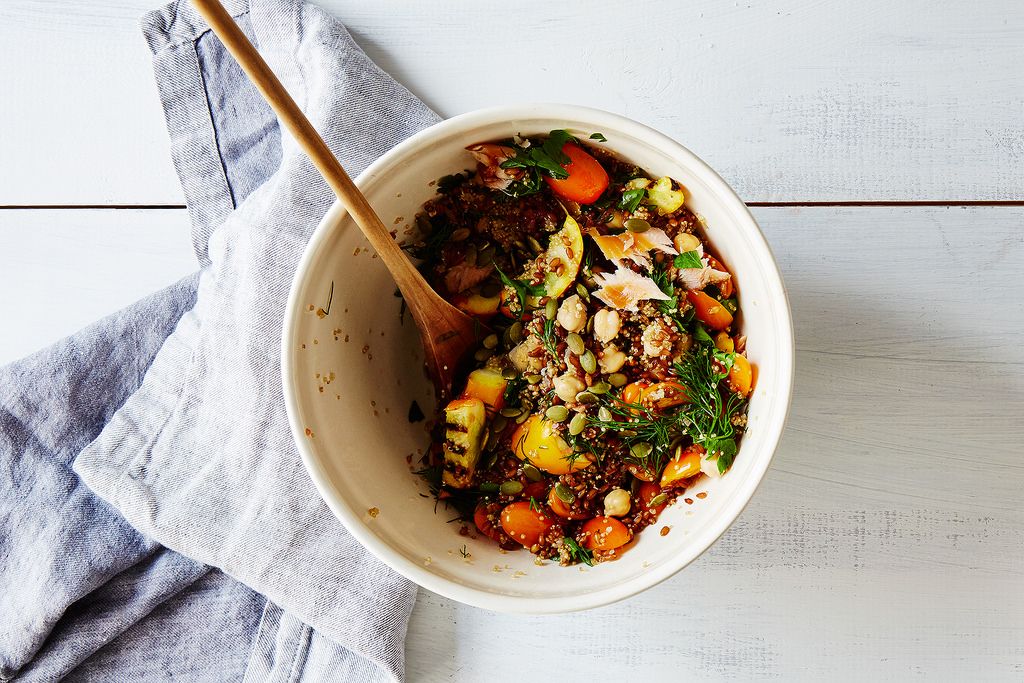
You know how salad always sounds so perfect for lunch, except for the part where, two hours later, you wind up snacky? Grain salads are the answer. (They're also the answer to neglected jars of whole grains you never seem to get around to cooking, picnics, potlucks, and lunches that don't require a queue at the microwave.) They're endlessly variable, meaning that if you have the basic composition down, you never need a recipe to put one together. The day's version is at the whim of your cravings and your pantry.
Read on for how to make a grain salad without a recipe:
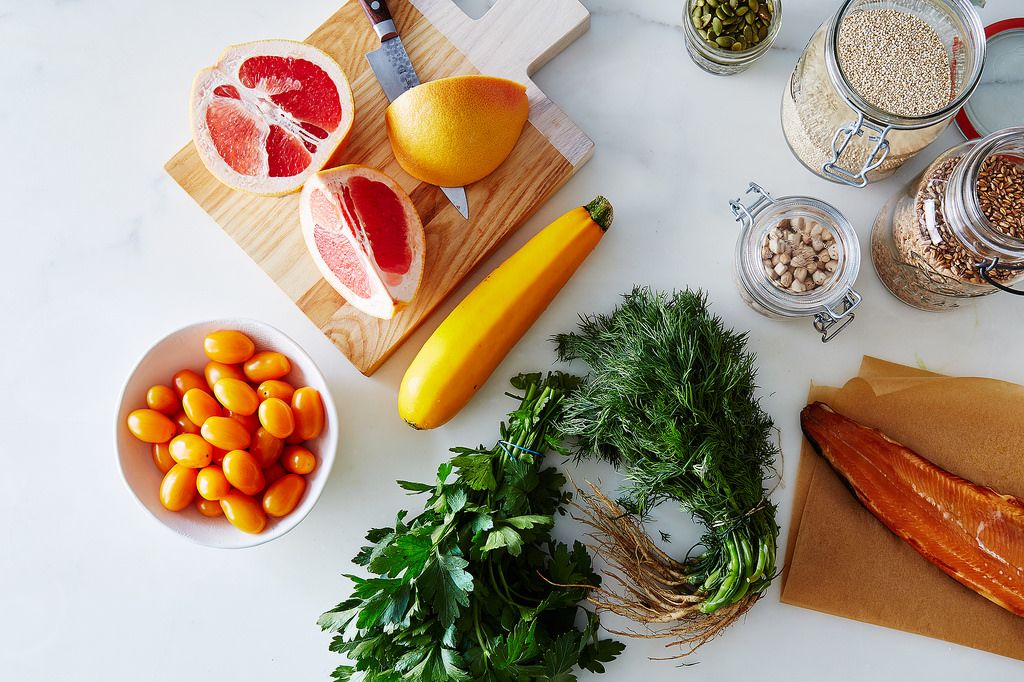
1. Choose and cook your grains.
You have a host of options here—you could use any number of wheat berry varieties, like emmer or einkorn, or that modified wheat berry, freekah, or you could go with quinoa, millet, farro, or rice. Grain salads are also a really great place for redeeming yourself with the grains in your pantry you always seem to bypass for one reason or another, like rye berries.
If you have grains leftover from another meal, by all means use them here, but keep this one point in mind: When you're making a grain salad, you want separate, intact grains that hold onto their starch, both so that they'll absorb dressing properly and so that they won't release that starch into the rest of the salad. That means that if you have clumpy brown rice in the fridge that maybe took in a bit too much water on the stove, it would find a better home in a pot of soup.
More: Why you should be toasting your grains.
For wheatberries and white rice, it’s best to boil. For millet, brown rice, and quinoa, I use the absorption method, which means bringing the grains and water (in 1:2, 1:1 1/3, and 1:1 1/2 ratios, respectively) in a saucepan to a boil, cooking at a bare simmer until the water has been absorbed, then resting with the lid on but off the heat for five minutes, draining them thoroughly in a colander if needed and laying them out to dry in a single layer. Towel them off (or let them air dry, if you have time), then transfer them to a salad bowl.
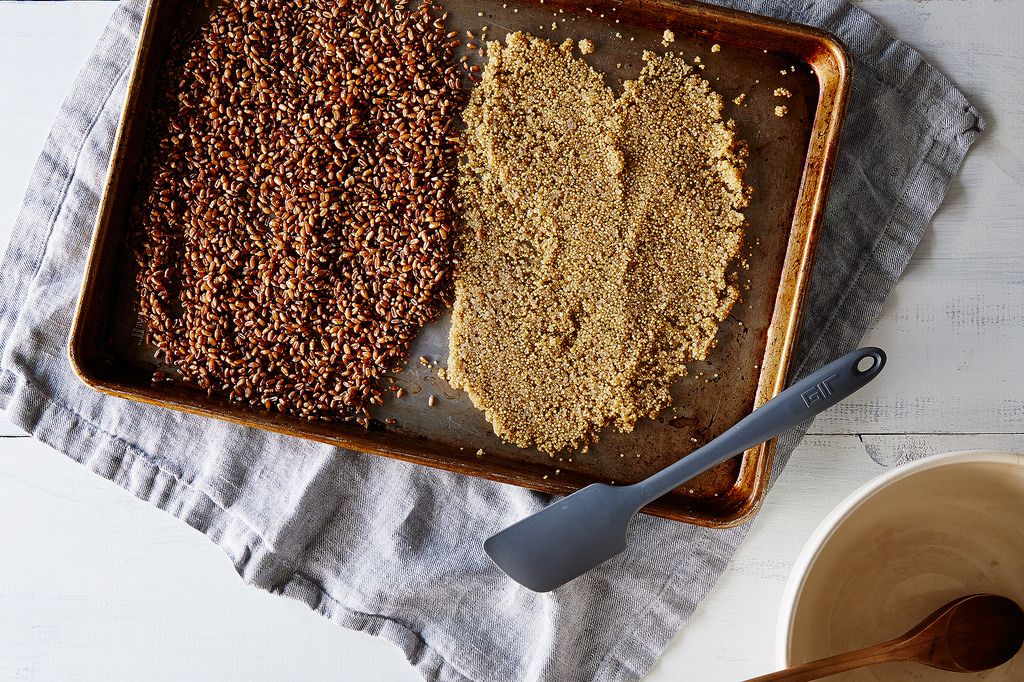
2. Choose your add-ins (vegetables, herbs, and proteins).
On the TODAY Show, Food52's cofounder Amanda Hesser added the feisty combination of pickled peppers (like Peppadews), smoked almonds, chopped celery, and chopped parsley, plus shredded leftover chicken and a basic vinaigrette shaken in a jar, to cooked farro and jasmine rice. In spring, I like to combine red quinoa with a bundle of blanched fava beans, thinly sliced garlic scapes, roasted and cooled early zucchini and spring onion bulbs, the onions' slivered green tops, and shredded mint leaves. In summer, I like to go super simple with an emmer salad using all raw vegetables: quartered and halved cherry tomatoes, diced green peppers, minced red onion, and lots of parsley and basil. In fall or winter, I might combine short-grain brown rice with lots of shredded nappa cabbage or collards, julienned carrots and cold-season radishes, mint, cilantro, and jalapeños.
Roast, sauté, and/or grill your vegetables—or go totally raw—but make sure anything you cook cools before combining it with your other ingredients. If you're blanching anything to take out the sting or lighten the crunch (garlic scapes, asparagus), cool them quickly in cold water after draining to preserve color, and make sure they're thoroughly dry before you add them to your salad bowl.
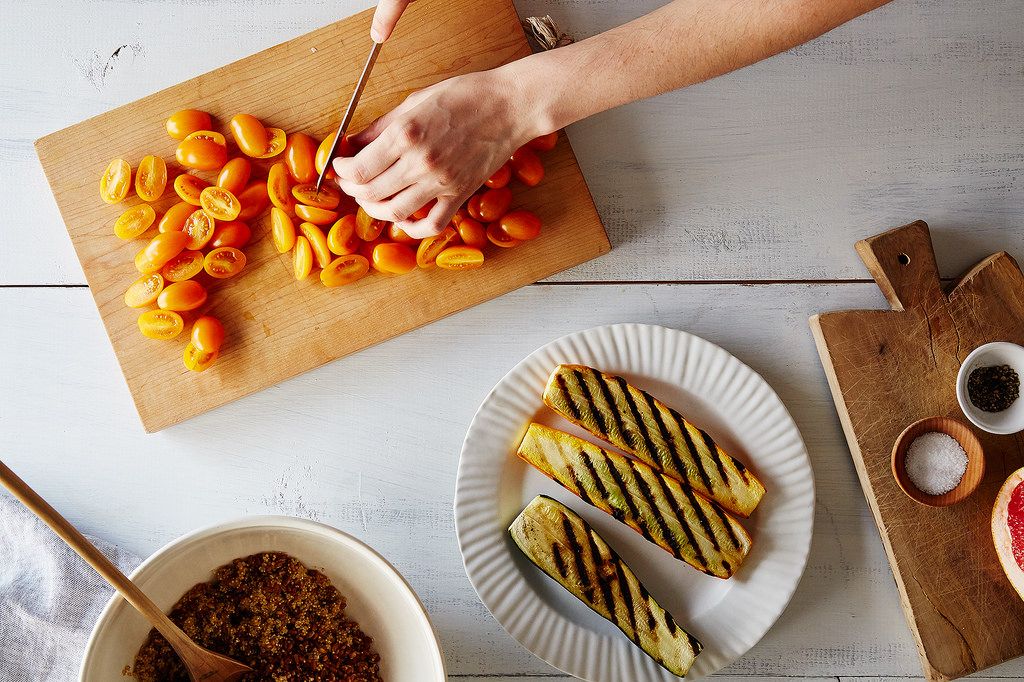
Be overzealous with the herbs, too—you can afford to use fistfuls of parsley, cilantro, chervil, chives, and mint, and smaller amounts of thyme, marjoram, and oregano for accent.
Protein is optional, especially if you're serving your grain salad as a side. My picks are beans, lentils, or chickpeas, cooked just until tender and drained well, or a couple of hard-boiled eggs for the side. But you could also use flaked smoked trout or mackerel, or last night's shredded roast chicken or pork shoulder.
Whatever add-ins you choose, cut them into pieces (or shreds) small enough that you can get little bits of most ingredients with each bite, and be generous with the amounts: Use at least as many vegetables by volume as grains, or more to your taste; I tend to go 1 part cooked grains to 1-1 1/2 parts vegetables and herbs to 1/2 part protein. After all your add-ins are prepped and dried, add them to your salad bowl with the grains.
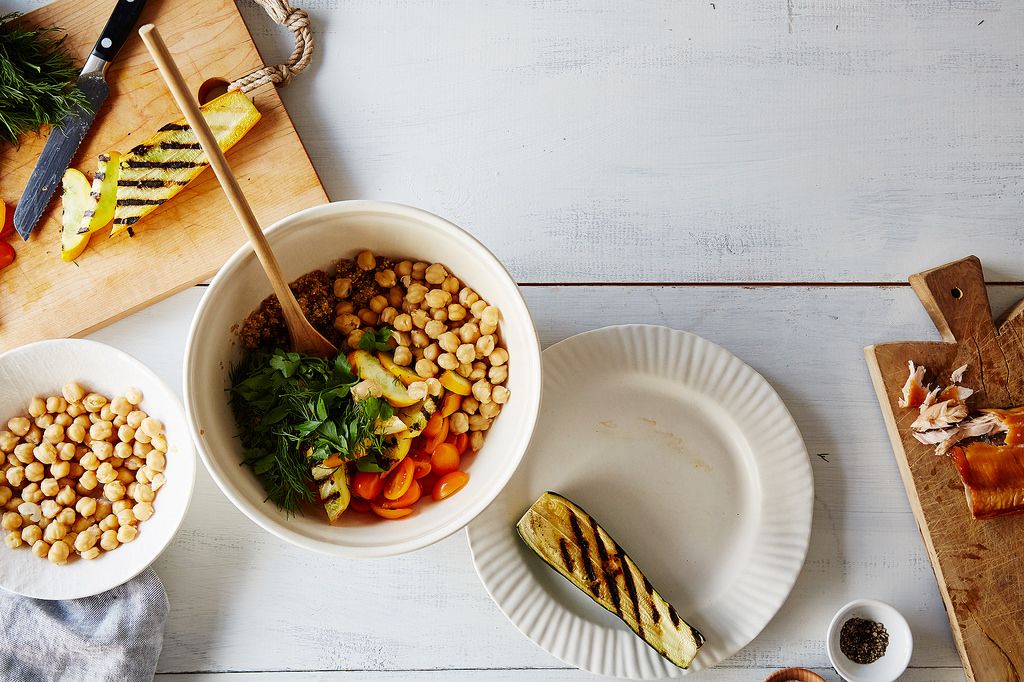
3. Make your dressing.
Because grains have such an earthy profile, balancing them with acid is important. Vinaigrettes and citrus-based dressings are best bets, but within this framework there's still tons of flexibility. The simplest red wine vinaigrette, made from whisking olive oil into red wine vinegar with salt and pepper to taste, is almost always a great choice, but white wine, Champagne, and sherry vinegars can be lovely and more nuanced, and rice vinegars with soy sauce, hoisin, sesame and peanut oils, lime juice, and fish sauce can take your salad in a totally different direction. Likewise, lemon dressings are versatile, but a grain salad can be a great place to try out a dressing made with orange, grapefruit, or lime juice, too.
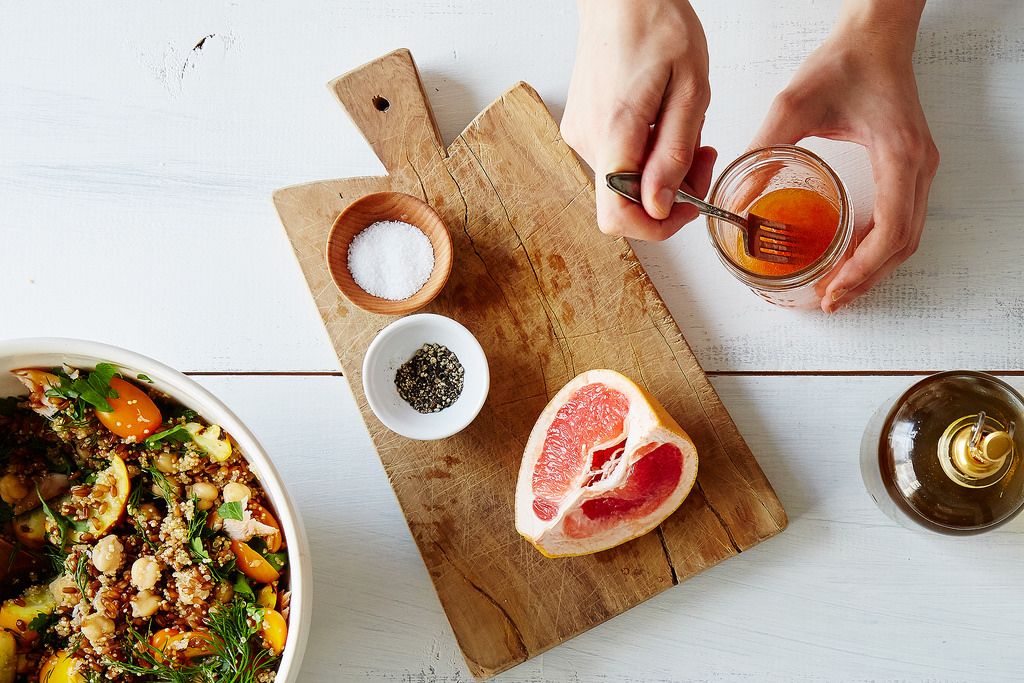
As for oil, if you're using olive oil, this is an occasion for your best bottles. If you want to go a different route, you could try a combination of sesame and toasted sesame or toasted peanut oils, or even something like a squash seed oil.
If you want, add Dijon mustard, ground cumin or fennel, smoked paprika, minced jalapeños, garlic pounded into a paste, or minced shallot macerated in vinegar before whisking in the oil. Make your dressing punchy; the grains can take it.
More: Make your vinaigrette without a recipe, too.
How much dressing you use depends on your salad's composition, but as a general rule, for each 1/4 cup (dry) of grains, you want about 2 tablespoons of dressing, assuming you've matched your cooked grain volume with vegetables and herbs and you've added in a little protein. If you've incorporated a lot of legumes or even more produce, you may want to up the quantity, so just taste and adjust as needed. Keep in mind that the longer a grain salad sits, the more dressing it will absorb. So if you're making it a few hours or a day ahead of time, err on the side of slightly overdressed, and it should be perfect at serving time.
Once your dressing is whisked together, pour it over your grains and vegetables and fold everything gently but thoroughly.

4. Gild the lily.
Cheese is a no-brainer here, especially something that has a little creaminess and crumbles nicely, like various blues or feta, but something aged and grated could also be the perfect touch, or even spoonfuls of really top-notch ricotta.
Toasted nuts and seeds are also a great choice: Lately I've been preoccupied with a blend from Yotam Ottolenghi's Plenty More that toasts pumpkin seeds, sesame seeds, almond slivers, and nigella seeds with hot chile flakes, salt, and olive oil. Other options you might consider: dried fruit, pitted and roughly chopped olives, or capers.
Stir some of your finishing ingredients through the salad, and leave a few to scatter over the top. Alternately, you can stir every bit of these ingredients through and add a few more herbs for garnish.

A few things to remember for a perfect composition and streamlining:
- Make sure your grains/beans/vegetables are dry before combining with the dressing to avoid watered-down salad.
- If you're going to be holding the salad for a bit before serving, keep the herbs in a separate container until just before serving so that they don't lose their vivid color and flavor.
- For quick meals throughout the week, prep and dress your grains (and legumes, if using) as many as 4 days ahead; add in your vegetables, herbs, and garnishes day by day as you go.
If you need a little inspiration, here are a few combinations to get you started:
- Einkorn, fava beans, roasted zucchini and red onions, garlic scapes, mint, parsley, red wine vinaigrette, and a mixture of toasted pumpkin seeds, sesame seeds, almonds, nigella seeds, and red pepper.
- Red quinoa, purslane, cherry tomatoes, cucumbers, red onion, fennel fronds, sherry vinaigrette, and feta.
- Short-grain brown rice, Napa cabbage, carrots, mint, cilantro, extra-firm tofu, lime-sesame oil-toasted peanut oil-rice vinegar dressing, and sesame seeds.
- Rye berries, shaved corn kernels, celery, Sungold tomatoes, scallions, dill, chives, sprouted mung beans, Champagne vinaigrette, and ricotta salata.
More: How to sprout your own grains, beans, and seeds.
- Red rice, green/purple/red bell or frying peppers, hot peppers, red onion, parsley, marjoram, red wine vinaigrette, capers, and pitted green olives.
- Emmer, roasted red peppers, parsley, chickpeas, lemon-garlic-cumin dressing, aleppo chile flakes, and toasted pine nuts.
- Farro, quinoa, cherry tomatoes, grilled zucchini, parsley, dill, chickpeas, smoked trout, grapefruit dressing, and toasted pepitas (what's pictured here).

Photos by Bobbi Lin
We're looking for contributors! Tell us what recipe you can make by heart without a recipe at editors@food52.com.








See what other Food52 readers are saying.